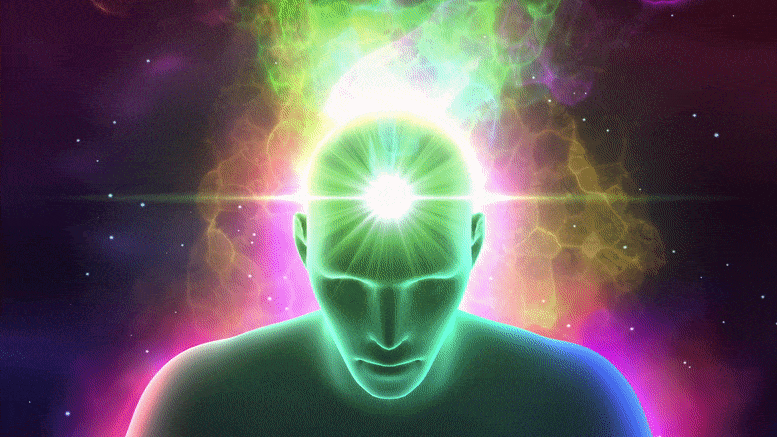
Some scientists believe consciousness is generated by quantum processes, but the theory is yet to be empirically tested.
One of the most important open questions in science is how our consciousness is established. In the 1990s, long before winning the 2020 Nobel Prize in Physics for his prediction of black holes, physicist Roger Penrose teamed up with anesthesiologist Stuart Hameroff to propose an ambitious answer.
They claimed that the brain’s neuronal system forms an intricate network and that the consciousness this produces should obey the rules of quantum mechanics – the theory that determines how tiny particles like electrons move around. This, they argue, could explain the mysterious complexity of human consciousness.
Penrose and Hameroff were met with incredulity. Quantum mechanical laws are usually only found to apply at very low temperatures. Quantum computers, for example, currently operate at around -272°C. At higher temperatures, classical mechanics takes over. Since our body works at room temperature, you would expect it to be governed by the classical laws of physics. For this reason, the quantum consciousness theory has been dismissed outright by many scientists – though others are persuaded supporters.
Instead of entering into this debate, I decided to join forces with colleagues from China, led by Professor Xian-Min Jin at Shanghai Jiaotong University, to test some of the principles underpinning the quantum theory of consciousness.
In our new paper, we’ve investigated how quantum particles could move in a complex structure like the brain – but in a lab setting. If our findings can one day be compared with activity measured in the brain, we may come one step closer to validating or dismissing Penrose and Hameroff’s controversial theory.
Brains and fractals
Our brains are composed of cells called neurons, and their combined activity is believed to generate consciousness. Each neuron contains microtubules, which transport substances to different parts of the cell. The Penrose-Hameroff theory of quantum consciousness argues that microtubules are structured in a fractal pattern which would enable quantum processes to occur.
Fractals are structures that are neither two-dimensional nor three-dimensional, but are instead some fractional value in between. In mathematics, fractals emerge as beautiful patterns that repeat themselves infinitely, generating what is seemingly impossible: a structure that has a finite area, but an infinite perimeter.
This might sound impossible to visualize, but fractals actually occur frequently in nature. If you look closely at the florets of a cauliflower or the branches of a fern, you’ll see that they’re both made up of the same basic shape repeating itself over and over again, but at smaller and smaller scales. That’s a key characteristic of fractals.
The same happens if you look inside your own body: the structure of your lungs, for instance, is fractal, as are the blood vessels in your circulatory system. Fractals also feature in the enchanting repeating artworks of MC Escher and Jackson Pollock, and they’ve been used for decades in technology, such as in the design of antennas. These are all examples of classical fractals – fractals that abide by the laws of classical physics rather than quantum physics.
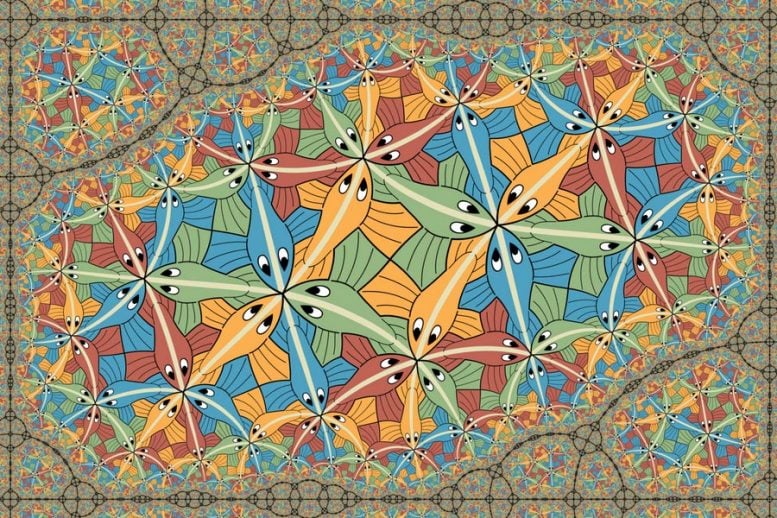
This extension of Escher’s Circle Limit III shows its fractal, repeating nature. Credit: Vladimir-Bulatov/Deviantart, CC BY-NC-SA
It’s easy to see why fractals have been used to explain the complexity of human consciousness. Because they’re infinitely intricate, allowing complexity to emerge from simple repeated patterns, they could be the structures that support the mysterious depths of our minds.
But if this is the case, it could only be happening on the quantum level, with tiny particles moving in fractal patterns within the brain’s neurons. That’s why Penrose and Hameroff’s proposal is called a theory of “quantum consciousness”.
Quantum consciousness
We’re not yet able to measure the behavior of quantum fractals in the brain – if they exist at all. But advanced technology means we can now measure quantum fractals in the lab. In recent research involving a scanning tunneling microscope (STM), my colleagues at Utrecht and I carefully arranged electrons in a fractal pattern, creating a quantum fractal.
When we then measured the wave function of the electrons, which describes their quantum state, we found that they too lived at the fractal dimension dictated by the physical pattern we’d made. In this case, the pattern we used on the quantum scale was the Sierpiński triangle, which is a shape that’s somewhere between one-dimensional and two-dimensional.
This was an exciting finding, but STM techniques cannot probe how quantum particles move – which would tell us more about how quantum processes might occur in the brain. So in our latest research, my colleagues at Shanghai Jiaotong University and I went one step further. Using state-of-the-art photonics experiments, we were able to reveal the quantum motion that takes place within fractals in unprecedented detail.
We achieved this by injecting photons (particles of light) into an artificial chip that was painstakingly engineered into a tiny Sierpiński triangle. We injected photons at the tip of the triangle and watched how they spread throughout its fractal structure in a process called quantum transport. We then repeated this experiment on two different fractal structures, both shaped as squares rather than triangles. And in each of these structures we conducted hundreds of experiments.
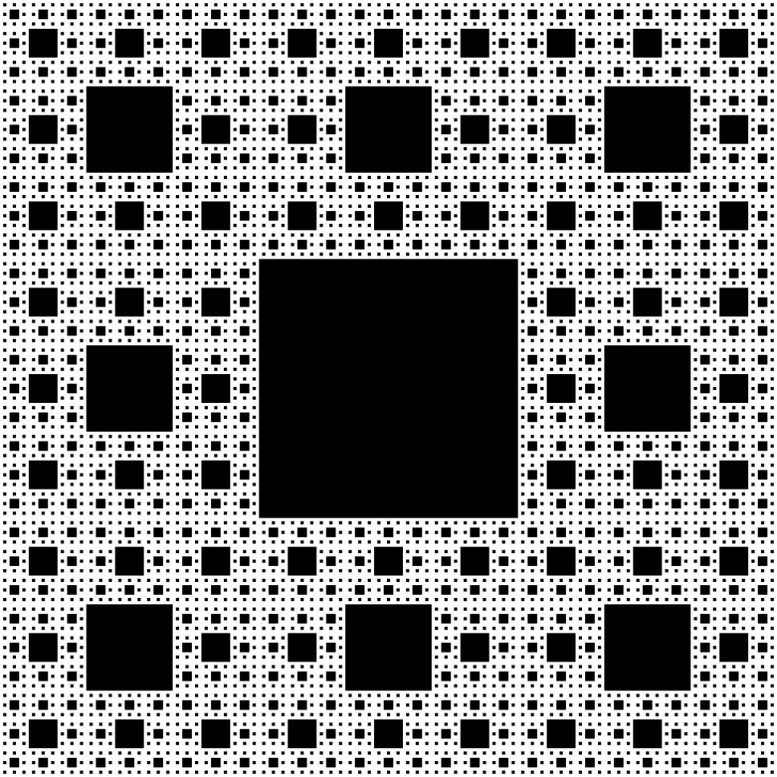
We also conducted experiments on a square-shaped fractal called the Sierpiński carpet. Credit: Johannes Rössel/wikimedia
Our observations from these experiments reveal that quantum fractals actually behave in a different way to classical ones. Specifically, we found that the spread of light across a fractal is governed by different laws in the quantum case compared to the classical case.
This new knowledge of quantum fractals could provide the foundations for scientists to experimentally test the theory of quantum consciousness. If quantum measurements are one day taken from the human brain, they could be compared against our results to definitely decide whether consciousness is a classical or a quantum phenomenon.
Our work could also have profound implications across scientific fields. By investigating quantum transport in our artificially designed fractal structures, we may have taken the first tiny steps towards the unification of physics, mathematics and biology, which could greatly enrich our understanding of the world around us as well as the world that exists in our heads.
Written by Cristiane de Morais Smith, Professor, Theoretical Physics, Utrecht University.
Adapted from an article originally published on The Conversation.![]()


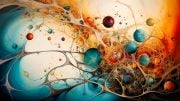

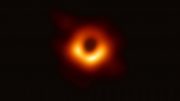




Fascinating. fractal quantums. I already receive emails from sci-tech. Thanks
This proposal of a connection between quantum physics and intelligent thought comes up now and then, and is flat out wrong on many levels.
The kind of reasoning and perception and planning required by a human is needs to be robust and organized, it is essentially an engineering project on a large scale, engineered by evolutionary mechanisms.
The only tenuous connection here is that quantum physics seems to be described by probabilities, and the processes in the brain, examined in any one place, seems probabilitistic, but that is the only similarity. The brain’s circuits have been ‘engineered’ to remove or work around randomness, in order to behave reliably enough to allow humans to survive. Randomness and noise are the enemy at every level of abstraction in engineered systems. You do not need to feed in randomness to get seemingly random behavior. Any complex digital logic circuit, while deterministic at the gate level, soon appears chaotic and random if you take a random peek into some set of wires.
This argument is usually made by physicists who have very little intuition about computation and computer engineering, and basically make the argument that “consciousness is complicated and we don’t understand it and looks kind of random, and quantum physics is complicated and appears kind of random, so they are the same thing”. As a theory it is “not even wrong” to quote Pauli
There’s few things as gratifying to soul as the moments you’re lucky enough to spot an engineered system contemplating the meaning of it’s own creation, it’s existence, and asking itself, “If someone peeking at my wires were to cut one and disrupt my circuits…is that the end of my existence?” You know, just an engineered system in the wild taking it all in!
My personal favorite is when they get a wild hair in the middle removing and working around the randomness like they were engineered to do then out of nowhere they jump up, dance wildly, and sing I think we’re alone now like they’re Tiffany!! Sometimes the need to let loose randomly makes them feel happy inside! Those silly quantum philosophers don’t realize that’s just a calculator being a calculator as engineered!
You perhaps ought to read more about quantum biology. Schrödi ger himself wrote a book about it.
The point is, many biological processes (such enzymatic catalysis) have been suggested, with evidence, to make use of quantum mechanics. Even uncomplicated biological processes that we once thought we understood.
So it’s really not just a superficial connection between consciousness and quantum mechanics as you suggest – but rather a theme of biology operating around quantum principles (once again, suggested by evidence).
Not really speaking of the article, but of your response I have to disagree in that there are many processes in the body that do rely upon nonlinear type processes rather than hard classical engineering. They are actually more robust in that a hard engineered type of system in that a small perturbation in a classical type system can send it to a state that is non recoverable versus other “fuzzy” processes that can find its way back to an equilibrium which is VERY important to life processes. There are many articles on this, and you can see yourself that say, a change in temperature, a change in eating, a change in input give a discrete exact change in response the way a classical system would that the input and output is more along nonlinear responses. As to the article, of course anything made of matter or energy, like our biology would be connected and have a quantum nature as well including the “dumb” cells of our body and precise chemical interactions which at the base of it goes into the nature of physics including quantum physics.
We do have processes that are small enough in our brain that they could be affected by quantum processes. To me, I am not sure if that is related to how our brains “generate” consciousness, but more to me makes me wonder if it is a way humans are connected or can perceive things outside of themselves by that way and also the fact that where observation “collapses” quantum states, that we have an effect upon “reality” and physics itself as well. How to study that, not really sure, but research like this is fascinating in its attempts.
Henry, your assumption that the brain is an “engineering project” is absurd beyond measure. There is no reason whatsoever to believe the brain even resembles modern computational systems, biological systems obey laws which are complex by nature. It is absolutely valid to think that a full description of consciousness is incomplete without inclusion of the quantum mechanical effects occurring at the molecular level.
Perhaps physicists have little intuition about computation (which is somewhat unlikely since we had a hand in developing the field), but I find you lack not only intuition, but the most basic understanding of how complex behaviors emerge from non linear systems. Additionally, if you understood the basics of statistical physics, you would realize that probabilistic descriptions can lead to seemingly deterministic outcomes. After all, the strength of evolution is to direct the inherent randomness in biological systems towards adaptation
I would agree that the brain is just millions of years of tape and glue, like every other biological construct. I have no personal opinion on what consciousness is and not much need to wager on one, but I am very interested to see the winning result when we find it.
Quantify your dreams
I am always amazed with physicists’ audacity to think they can tackle phenomena outside their “scale” of investigation. What’s next to expect….biologists and neuroscientists giving lectures on which Quantum interpretation is the correct one.
Consciousness is the abstract concept of a quality displayed by a biological structure.
Any other New alternate theories of consciousness ?
The answer for this is yes.The QC the optimized practice of economy can do this.Genetics is the key.Immence following of metascience with own understanding arises consciousness.
Fascinating and well explained.
Consciousness is not a product of the brain. The brain is material, consciousness is not.
So, you guys should turn your focus to the vedantic teachings
Dr. Donald Hoffman would disagree.
Check out the work being done by the UVA Division of Perceptual Studies at Uvadops.org
You may be on to something. Consciousness is the recognition of patterns. Thinking is sending strings to other patterns to make a decision. Since we live in a static Murkowski (x, y, z, t) space where only one thing can exist in one (x, y, z) location at the same time (t), we forget that patterns can be moving energies painting a picture. Consciousness is projecting energy into space for space to accomplish something as a series of (x, y, z, t) pixels in a painted landscape of energy. The pattern produced may be in the form of fractals since the same pattern may be similar to a mathematical equation in which you substitute values to give that pattern a value. Thus the field or equations must be transported as a fractal pattern to another location. Thus there’s a self-similarity in the field equation as well as the resulting pattern so it has to be transferred as a field which is more efficient than individual pieces to be reconstructed.
What makes anyone think we’re supposed to prove consciousness
We will probably be able to map out a consciousness pretty soon very fascinating!
It is very interesting to try and capture and/or measure what is. It is a fallacy of the human mind that this can be done, any measurement is an incomplete expression of what is. Everything is beyond measure in its fullness. To try and take something that is infinite such as consciousness and attempt to make it tangible is laughable. I hope humans will realize on a grand scale that the beauty and joy of life is in the experience of it. Any longing or desire for it to be more than it is or to explain it is suffering. With all of our technology and education there are more and more people who become lost from peace from truth. I hope humans come back to the knowledge and simplicity of living in harmony with nature and of meeting our basic needs such as food, shelter, and connection, and the experience and Knowing that this leads to a deep and fulfilling life.
Amen
Epic. Thank u. I concur!
I am not sure, how are they able to relate laws with consciousness, as i have been testing it for years. All I could relate is, consciousness is a kind of vibration in space-time that creats reality.
The universe is holographic.
I believe consciousness is not physically shaped nor seen to be measured but instinctively seen and measurable. I call natural patterns “classical conjoined fractals”. Or Cont-Simi-fractals on base mount.
In my Alien world, we don’t relate like humans and the use of consciousness differs. Consciousness is relatively active or inactive and the output our behavioural function.
The blood, heart, brain and oxygen are all supporting consciousness to be active and coexist in the human body but the minute any of these consciousness support (you humans call it life support) fails consciousness leaves the body rendering it useless. Consciousness is life and cannot be seen with the naked eye in the other world which scientists don’t believe exists.
But consciousness existed before the universe began. Humans are limited in universal intelligence to intellectually understand this.
The nature of man is similar in fractal to the nature of the owner of nature. Mans basic nature is ownership, leadership and desire for immortality. So man have to fight and conquer the owner of nature to become immortal. I know where and how to get immortality but its bigger than quantum science. I have studied man and his planetary history. Mam have refused to acknowledge himself and accept the owner of nature. That is the genesis of the failure of man. When you don’t know who you are, you don’t know why you exist and where you are going. So man is lost with wrong vision and mission altogether… Alien
Remember a dream. You move from location to location. Feelings, senses, people, change while constantly remaining connected.
I’m no where near smart enough to test the data. But I feel this is right.
We only understand quantum physics in the very small and cold, but it doesn’t mean it doesn’t exist in the very large and or warm. We just don’t know how yet.
For what its worth, our body does not operate at room temperature (23 C) like the article stated, its more like 37 C.
Consciousness can only be experienced. I thought Stuart knew this!!
Ancient India texts have some mentioning on many unknown things including consciousness that modern world is trying to hack. Hope you may end up getting something useful..
Does quantum entanglement guarantee connection and response simultaneously no matter the location in relation to paired particles. I’m a dumbass so please don’t blast my ignorance if I misunderstood
Max Tegmark has shown mathematically that quantum effects will not persist long enough to produce any meaningful effect. https://physicsworld.com/a/do-quantum-effects-play-a-role-in-consciousness/
Max Tegmark has shown mathematically that quantum effects will not persist long enough in the human brain to produce any meaningful effect. https://physicsworld.com/a/do-quantum-effects-play-a-role-in-consciousness/
The article is full of speculations. The following is highly ridiculous:
“If quantum measurements are one day taken from the human brain, they could be compared against our results to definitely decide whether consciousness is a classical or a quantum phenomenon.”
Assuming someone successfully takes quantum measurements in the brain, it would connote that quantum phenomenum takes place therein, it definitely does NOT equate to or necessarily imply a link with consciousness.
The brain is material whereas consciousness or self-awareness of life, is not.
So long Physics focuses on matter and negelects the spiritual dimension (necessity of a designer and law-giver), it cannot fully comprehend the visible and invisible universe.
Our brains are not creating consciousness. They receive and filter consciousness. Like a radio that receive the signal and the signal which has received depends on which channel is tuned in.
Something else that could explain consciousness: hubris.
Bogus theory created to project as if consciousness is created by matter.
No no no, quantum mechanical rules are not based on temperature, quantum mechanics happens all the time at every temperature, including the core of a neutron star, which is a absolutely not cold. Look up quantum biology, quantum mechanics are used inside living things. This statement is total nonsense, quantum computers need to be cold only because we are trying to control quantum mechanics.
I love epi genetics studied by Bruce Lipton. How can we evolve as a species if we constantly want to stay in the same place. Humans have always feared change. Something that is inevitable. But once we grasp the fact that we create our own reality all fear diminishes. I believe in quantum physics and I have had many personal experiences and documentation to back up all of my experiences for those who need the visual. I found its best to go at life with an optimistic open mind so we do not debunk our own experiences perpetuated by the experiences of others. Peace on your journey to the truth. Love and allow. We just might learn something as we are eternal beings in a constant state of evolving and I find that to be delicious.
Plot twist – our minds are a fractal of a larger more cosmic consciousness. Check out Cosmos and Psyche by Richard Tarnas (before coming at me with anti-astrology opinions)
You know how you solve that problem of temperature at the quantum conscious level……?????
Cryogenics!!!! but the to bing the physical body back to “living consciousness” would be difficult but maybe not in the near future!!!! Stay open-minded folks!!!!
Consciousness cannot unfortunately be explained by quantum mechanics. Because it is above QM. LET ME PUT IT IN ANOTHER WAY. IT CAME BEFORE QUANTUM MECHANICS.
It is time scientist look into Nirodasamapthiya of Theravada Buddhism a very high level of concentration , where the blood circulation and breath stops in the body for weeks, which has a link to quantum entanglement space. An article will appear in Quora soon.
Has any scientist considered the possibility that awareness/consciousness is itself not part of the physical universe? Not related to classical or quantum theories at all? That perhaps it is the ultimate source of the physical universe on both the classical and quantum levels? One thing that I notice is that when talking about “nothing” the closest anyone can come to describing it is infinite, empty, black space. However even that is “something.” It is not possible for the mind to conceive of true “nothingness” since it would not even have infinite empty black space. The logical conclusion is that there is no such thing as “nothingness” in the physical universe. True “nothingness” would be a lack of space, time, matter, energy or any quantum fields. Therefore, it would not be subject to analysis by either classical or quantum physics. This then brings up the quandary – how is it that we are able to even have a concept that there could be “nothingness” unless consciousness is itself “nothingness?”
If you would like to grow your familiarity just keep visiting this website and be updated with the most recent news posted here.|